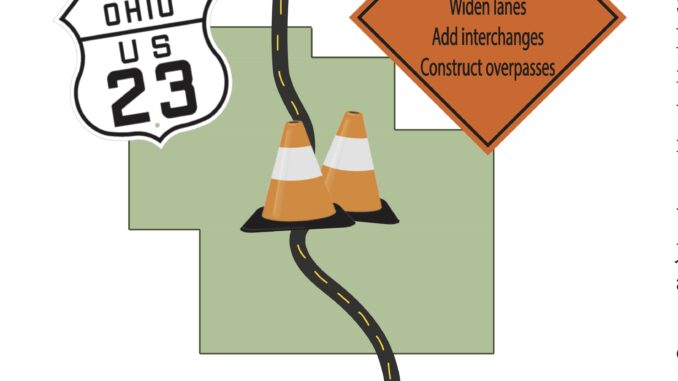
photo credit: Sakara Ross
Perhaps the worst thing about driving is that everyone else has to drive too. In a rapidly-growing Delaware County, that consequence leads to its main road being an ever-growing nuisance to commuters.
For years, US 23 has suffered problems regarding traffic control. The road has faced issues regarding accidents and backed up traffic especially during peak driving hours like the rush hour commute. In June, Gov. Mike Dewine and Ohio Department of Transportation Director Jack Marchbanks announced recommendations regarding the corridor in Delaware County.
“Route 23 is way too small for the infrastructure and the growth that this area has seen. There is too much traffic, lots of accidents, and so forth,” Assistant Principal Dr. Kim said.
The primary focus of the recommendations is on road capacity and reducing traffic congestion. According to a news release from the official website for Gov. Mike Dewine, Route 23 from Worthington to Waldo exceeds road capacity by 30 percent, rush hour commutes on the road are about 40 minutes long and could increase to 75 minutes by 2050 if upgrades are neglected on the road.
“Several factors have resulted in heavy congestion, especially during peak times,” ODOT Public Information Officer Matthew McGuire said. “This results in slow, inconsistent travel times and delays, as well as safety concerns as crashes have occurred at numerous locations along the route.”
Between 2020 and 2024, nine deaths were reported on the road, and 72 injuries were reported because of crashes; upgrades to the road could lead to a reduction in traffic crashes by 50 percent.
“Route 23 is a case of too much population for a road that isn’t supposed to handle that many cars a day,” Mathematics Teacher Robert Roth said. “It’s probably my most dreaded road in Central Ohio to drive on.”
Currently, Route 23 in Delaware County has most of the road running four lanes total, with 39 trafficsignals existing on the road. The recommendation suggested dropping the number of traffic signals on the road to a number below seven and widening them current configuration, as well as adding interchanges and overpasses to reduce the number of at-grade intersections.
“Central Ohio is growing rapidly, so demand on US 23 only stands to increase in the coming years,” McGuire said. “Improving safety and operations along US 23 and making travel more consistent aligns with the needs that growth will bring.”
Upgrades for the corridor have not been finalized yet, but the project is expected to cost in a range of $1.4 to $1.9 billion with upgrades happening over time. Several meetings to discuss the upgrading project occurred in August of this year.
“There is a chance these upgrades can go through; it just would take more patience and tax dollars,” Kim said.
Growth in Delaware county in the past couple of years have led to southern areas of the county being more developed than others. As a result, costs and impacts that come with road upgrades may be higher in some sections of Route 23.
“In general, the further south you travel along the corridor, the more developed and densely populated the route is, which can mean less space/flexibility and higher costs/impacts for some of the alternatives being evaluated,” McGuire said.
If these upgrades are finalized and implemented, the issue of Route 23 being a mess to drive on may not be an issue in the future. However, the one question to ask is if these upgrades will prevent the same issues from popping up several years in the future in a rapidly growing Delaware County.


